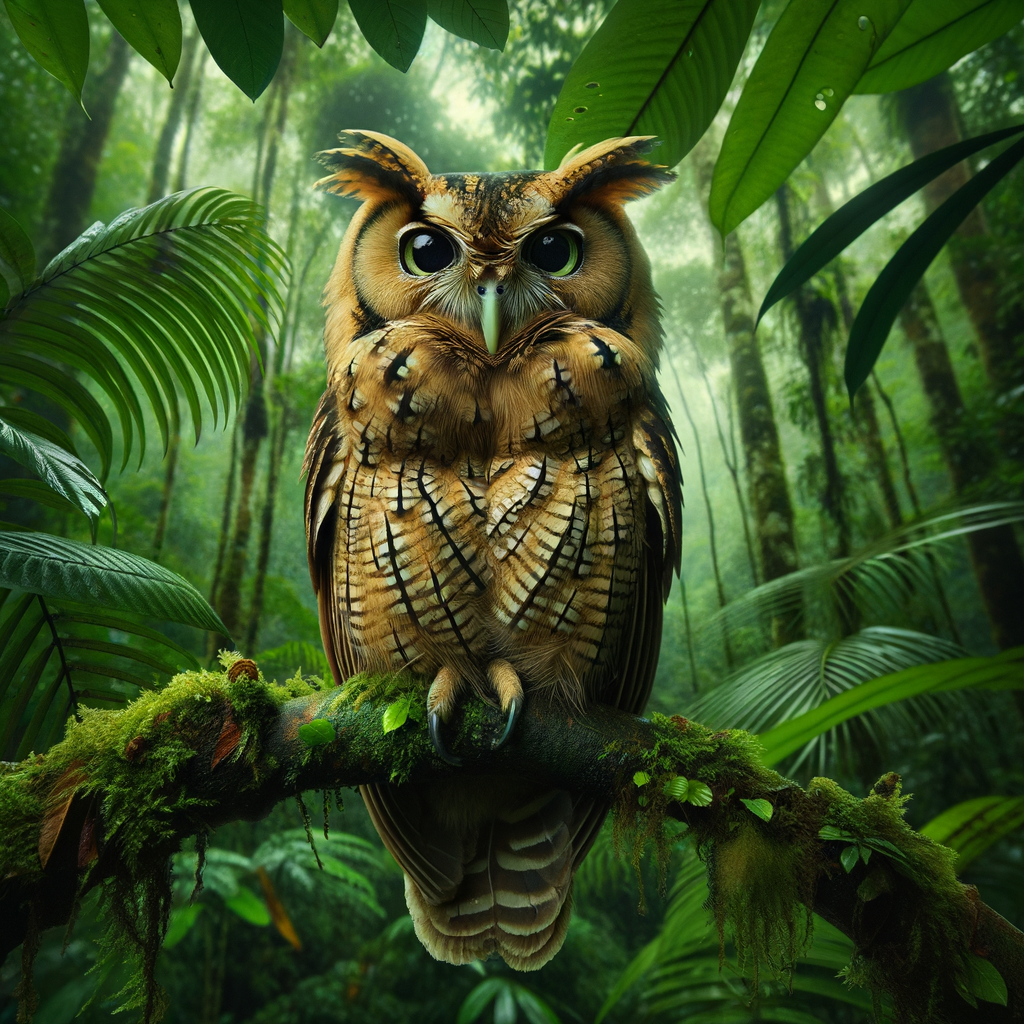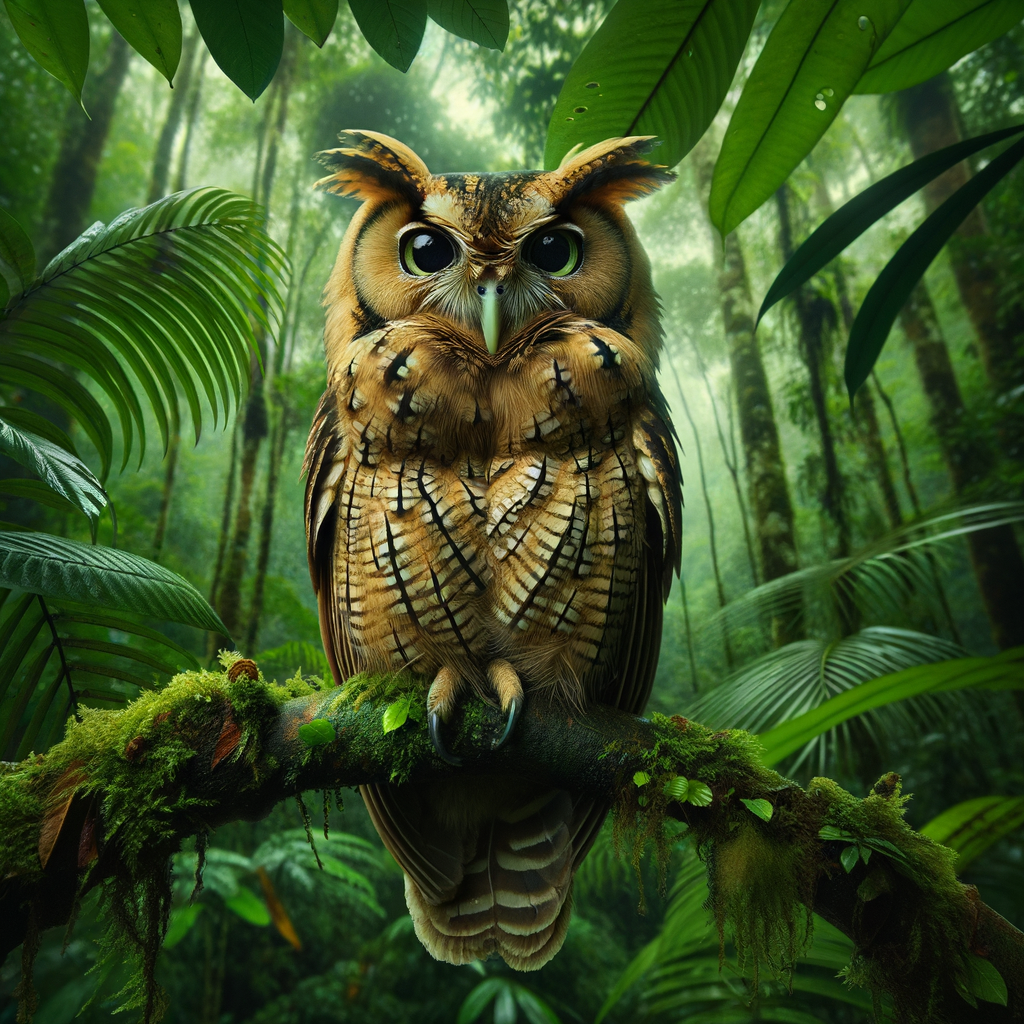
Introduction to Rainforest Owls
When we think of the rainforest, we often imagine a world filled with vibrant colors, exotic plants, and a symphony of sounds from a variety of creatures. Among these creatures, one stands out with its distinct hoot and mesmerizing eyes – the owl. This post will introduce you to the fascinating world of rainforest owls and their crucial role in maintaining biodiversity.
-
- Overview of Rainforest Owls
Owls are nocturnal birds of prey known for their distinctive call, large eyes, and silent flight. There are around 200 species of owls worldwide, and a significant number of these reside in rainforests. Rainforest owls vary in size, color, and habits, but they all share a common trait – they are excellent hunters. Some of the well-known rainforest owls include the Spectacled Owl, the Amazonian Pygmy Owl, and the Crested Owl.
-
- Importance of Owls in Biodiversity
Owls play a crucial role in maintaining the balance of the rainforest ecosystem. As predators, they help control the population of rodents and insects, preventing these species from overpopulating and damaging the forest. Moreover, the presence of owls is often an indicator of a healthy ecosystem, as they need a diverse and abundant food supply to thrive. Thus, the survival and prosperity of owls are closely tied to the overall biodiversity of the rainforest.
In the following sections, we will delve deeper into the rainforest ecosystem, explore different species of owls, and understand how these magnificent creatures act as guardians of biodiversity. So, let’s embark on this exciting journey into the world of rainforest owls!
Understanding the Rainforest Ecosystem
The rainforest ecosystem is a complex and vibrant world, teeming with a variety of life forms. It is a unique environment that plays a crucial role in maintaining the planet’s overall health. Let’s delve deeper into understanding this ecosystem, focusing on the role of its wildlife, particularly the owls.
Role of Rainforest Wildlife
Wildlife plays a significant role in the rainforest ecosystem. They contribute to the balance and health of these forests in several ways.
-
- General Role of Wildlife in Rainforests
Wildlife is the lifeblood of the rainforest. They help in the pollination of plants, seed dispersal, and nutrient cycling. For instance, animals like monkeys and birds eat fruits and disperse the seeds through their droppings, aiding in the growth of new plants. Insects and other small creatures decompose fallen leaves and dead animals, returning essential nutrients back to the soil.
-
- Specific Role of Owls in the Rainforest Ecosystem
Owls, often overlooked, play a vital role in the rainforest ecosystem. As predators, they help control the population of rodents and insects. This is crucial as unchecked rodent populations can lead to the overconsumption of plant seeds, impacting the growth of new plants. Moreover, owls’ hunting habits also contribute to the natural selection process, ensuring only the fittest survive.
Understanding the role of wildlife, including owls, in the rainforest ecosystem is essential. It helps us appreciate the delicate balance of nature and the importance of preserving these habitats.
Importance of Biodiversity
-
Definition and Importance of Biodiversity
Biodiversity, or biological diversity, refers to the variety of life on Earth. It includes all organisms, species, and populations; the genetic variation among these; and their complex assemblages of communities and ecosystems. Biodiversity is important because it provides us with a wealth of resources, like food, medicine, and materials. It also supports essential ecosystem services such as soil fertility, waste decomposition, and pollination, all of which make life possible.
Furthermore, biodiversity plays a crucial role in climate regulation and provides recreational and cultural benefits. It’s like a giant, complex puzzle. Each piece, no matter how small, has a unique role in maintaining the balance of the system. When a piece is lost, it affects the entire picture.
Benefits of Biodiversity Provides a variety of resources Supports essential ecosystem services Plays a role in climate regulation Offers recreational and cultural benefits -
Impact of Biodiversity on the Rainforest Ecosystem
The rainforest ecosystem is one of the richest in biodiversity on the planet. This biodiversity is not just a source of beauty and wonder, but it’s also critical for the health and resilience of the rainforest. Each species, from the smallest insect to the largest tree, has a specific role in the ecosystem, contributing to its overall function and stability.
For instance, the variety of plant species in the rainforest contributes to the regulation of the global climate by absorbing carbon dioxide and releasing oxygen. The diverse animal species, including owls, help control pest populations and disperse seeds, promoting forest regeneration. In short, biodiversity is the lifeblood of the rainforest ecosystem, making it a vibrant, resilient, and productive environment.
Roles of Biodiversity in the Rainforest Regulates the global climate Controls pest populations Disperses seeds for forest regeneration
Owl Species in Rainforest
There are numerous owl species that call the rainforest their home. Each species possesses unique characteristics and plays a vital role in the ecosystem. Let’s dive deeper into the world of these fascinating creatures.
-
Overview of Different Owl Species in Rainforests
There are many different owl species that inhabit rainforests across the globe. Here are a few examples:
Owl Species Region Spectacled Owl Central and South America Rufous Owl Australia African Wood Owl Africa These are just a few examples of the diverse owl species found in rainforests. Each species has adapted to its specific environment and contributes to the overall health of the rainforest ecosystem.
-
Unique Characteristics of Rainforest Owls
Rainforest owls possess unique characteristics that set them apart from other owl species. Here are a few examples:
- Adapted Vision: Owls in the rainforest have large eyes that allow them to see clearly in the dark, dense forest.
- Silent Flight: Their feathers are designed in a way that allows them to fly silently, helping them hunt effectively.
- Diverse Diets: Rainforest owls have a diverse diet, including insects, small mammals, and other birds. This helps control the population of certain species and maintains balance in the ecosystem.
These unique characteristics not only make rainforest owls fascinating creatures, but also crucial components of the biodiversity in these lush habitats.
Understanding the different owl species in the rainforest and their unique characteristics can help us appreciate their role in the ecosystem. As we continue to learn more about these creatures, we can better protect them and the biodiversity they help maintain.
Owls as Biodiversity Guardians
As we delve deeper into the role of owls in the rainforest, we discover that they are not just inhabitants, but guardians of biodiversity. Let’s explore how they contribute to maintaining the ecosystem balance.
Contribution to Ecosystem Balance
Owls play a crucial role in maintaining the balance of the ecosystem. They are nature’s pest controllers, helping to keep the population of rodents and insects in check. This is vital for the health and survival of the rainforest.
-
- How Owls Contribute to Maintaining Ecosystem Balance
Owls are known as apex predators, meaning they are at the top of the food chain. They feed on a variety of creatures, including rodents, insects, and even other birds. By controlling these populations, owls prevent overgrazing and the spread of disease. This contributes to a healthier and more balanced ecosystem.
-
- Case Study: Impact of Owls on a Specific Rainforest Ecosystem
Let’s take a look at the Amazon Rainforest, home to a diverse range of owl species. A study conducted here showed that the presence of owls significantly reduced the population of destructive rodents. This led to a healthier forest with more robust plant life, demonstrating the vital role owls play in maintaining biodiversity.
Owls are not just inhabitants of the rainforest, but key players in maintaining its health and biodiversity. Their role as predators helps to keep the ecosystem in balance, proving that every creature, no matter how big or small, has an important part to play in the grand scheme of nature.
Owl Conservation Efforts
Conservation efforts are crucial in maintaining the balance of our ecosystems, especially in the rainforests where owls play a significant role. Let’s delve into the current initiatives and understand how they are helping maintain biodiversity.
-
- Current Conservation Efforts for Rainforest Owls
There are several ongoing efforts to conserve rainforest owls. These include habitat protection, captive breeding, and public education. Habitat protection involves preserving and restoring the natural habitats of these owls, limiting human intrusion and deforestation. Captive breeding is another method where owls are bred in a controlled environment to increase their population. Lastly, public education plays a key role in conservation. By raising awareness about the importance of owls and the threats they face, people are more likely to support conservation efforts.
-
- How Conservation Efforts are Helping Maintain Biodiversity
Conservation efforts for owls have a ripple effect on the entire rainforest ecosystem. Owls are apex predators, meaning they are at the top of the food chain. By maintaining their population, we ensure the balance of the ecosystem. For instance, owls control the population of rodents and insects, which if left unchecked, could lead to an imbalance in the ecosystem. Moreover, the preservation of owl habitats also safeguards other species living in the same environment, thus promoting biodiversity.
The conservation of rainforest owls is not just about saving one species. It’s about preserving an entire ecosystem. As guardians of biodiversity, their survival is crucial for the health of our planet.
Final Thoughts
As we conclude, it’s important to look towards the future of rainforest owls and their role in biodiversity. There are several key areas to consider, including the challenges these owls face, the importance of conservation efforts, and how owls will continue to contribute to biodiversity.
-
- Current Challenges Facing Rainforest Owls
Despite their importance in the ecosystem, rainforest owls face numerous challenges. Deforestation is a major concern, with large areas of their natural habitat being destroyed for agriculture and urbanization. This not only reduces the space available for owls to live and hunt, but also leads to a decrease in their prey. Climate change is another significant issue, as it can alter the conditions of the rainforest and impact the owls’ food sources.
-
- Importance of Continued Conservation Efforts
Given these challenges, it’s crucial that conservation efforts continue. Protecting the rainforest and creating protected areas for owls to live and breed can help ensure their survival. Additionally, educating the public about the importance of owls and the threats they face can encourage more people to support conservation initiatives. For instance, in 2020, a conservation program in Brazil resulted in a 20% increase in the owl population, demonstrating the effectiveness of these efforts.
-
- How Owls Will Continue to Play a Role in Biodiversity
Owls play a key role in maintaining biodiversity in the rainforest. They control the population of rodents and other small animals, preventing overpopulation and promoting a balanced ecosystem. As long as owls continue to thrive, they will continue to contribute to the biodiversity of the rainforest. Therefore, ensuring the survival of owls is not just about protecting a single species, but about preserving the health and diversity of the entire ecosystem.
The future of rainforest owls and biodiversity is interconnected. By addressing the challenges owls face and supporting conservation efforts, we can help ensure a vibrant and diverse rainforest for future generations.






